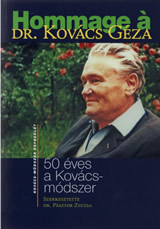Jubilee Conference on the 50th Anniversary of the Kovács-Method
Jubilee Conference
On the fiftieth anniversary of the Kovács Method, the Association held a celebratory conference in the concert hall of the Lajtha László Primary Art School at Pesterzsébet, Budapest, Hungary on 17 October 2009. The location is a special one in that this school hosted the music-school researches of the Kovács Method, that were headed by music teacher and university tutor Dr Zsuzsa Pásztor, currently chairperson of the Association for over twenty years from 1972 onwards. The patrons of the conference included Mrs Zoltán Kodály, Dr András Batta, Rector of the Liszt Academy of Music and Ákos Szabados, Mayor of Pesterzsébet.
The programme was fundamentally different from the usual conference programme. The day began with a refreshing forty-five-minute session of exercises with balloons, in which every participant readily joined. Short intervals for exercise were held between the talks, which prevented the kind of exhaustion that often bugs conferences.

Dr. Miklós Réthelyi, Professor of Anatomy Gives a Lecture
![]()
The talks included a presentation of the conference publication Hommage à dr. Kovács Géza as well as a presentation of the history of the Kovács Method in pictures. University professor anatomist Dr Miklós Réthelyi gave a talk on the neurological functions related to music-making. Dr Zsuzsa Pásztor’s film A Kokas-pedagógia – Út a totális zenei élményhez a korai gyermekkorban [The Kokas pedagogy. The way to a total musical experience in early childhood]. The programme would not have been complete without music, performed by teacher-performers Gabriella Csóka, Zsófia Bogár, Klára Schnierer Soós and Ilona Éva Tódy Schön. To round off the conference, teachers of the Kovács Method gave an account of their work in their respective institutions.

Relaxing Balloon Exercises for Conference Participants
![]()
Festive publication
On the occasion of the fiftieth anniversary of the Kovács Method, dr Zsuzsa Pásztor compiled a selection of Dr Géza Kovács’s unpublished works, entitled Hommage à dr. Kovács Géza.
The book consists of the end-of-term reports that Dr Géza Kovács’s composed for the directors of the school. The collection describes the pedagogy of the Kovács Method, its outlines and development from the start to the present day. Most users will be familiar only with the movement programme of the Kovács Method, yet there is so much more to it, and it is indeed a twentieth-century pedagogical concept on a grand scale, a programme for a way of life, a body of natural-scientific knowledge and a life philosophy whose early appearance makes it especially valuable. Dr Géza Kovács described 40–50 years ago things to which the literature is only nowadays beginning to respond. Moreover, he revealed knowledge that is regarded as new to this day.
In addition to the results, the publication tells the story of the struggle with red tape that researchers have had to undergo, the difficulties and miscomprehension they have had to face. The book describes the amazing passage a modest experimental set of exercises has made to become an independent area of study in university education.
We should like to take the opportunity to express our thanks to everyone without whose help this publication could not have been accomplished: Dr. Gaspar Scheurernek, Melinda Faragó and Ferenc Nádai, Zsófia László, Adrien Feith, Anna Négyesi és Zsuzsanna Schadl, as well as the students who have commemorated and evoked the spirit of our beloved teacher in their writings.

